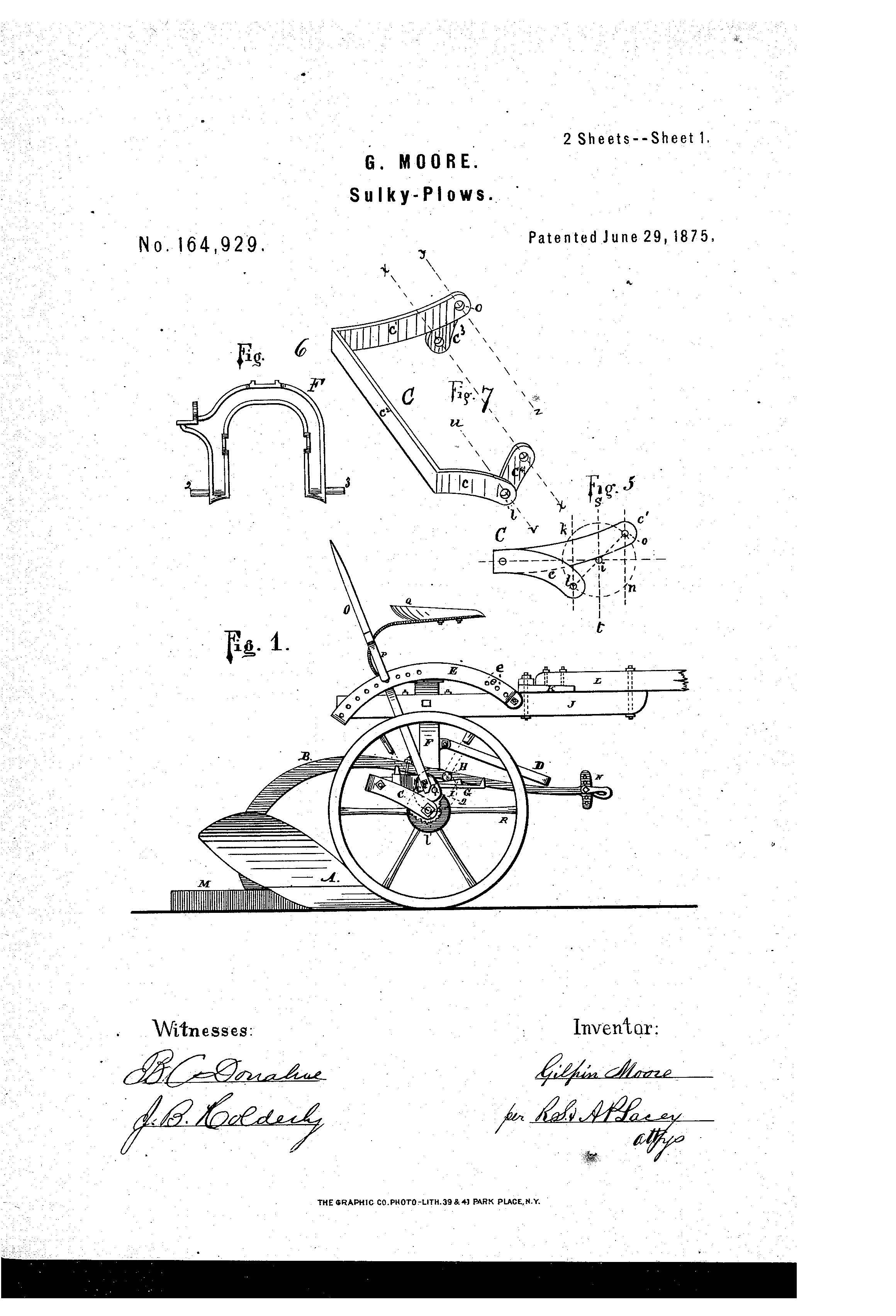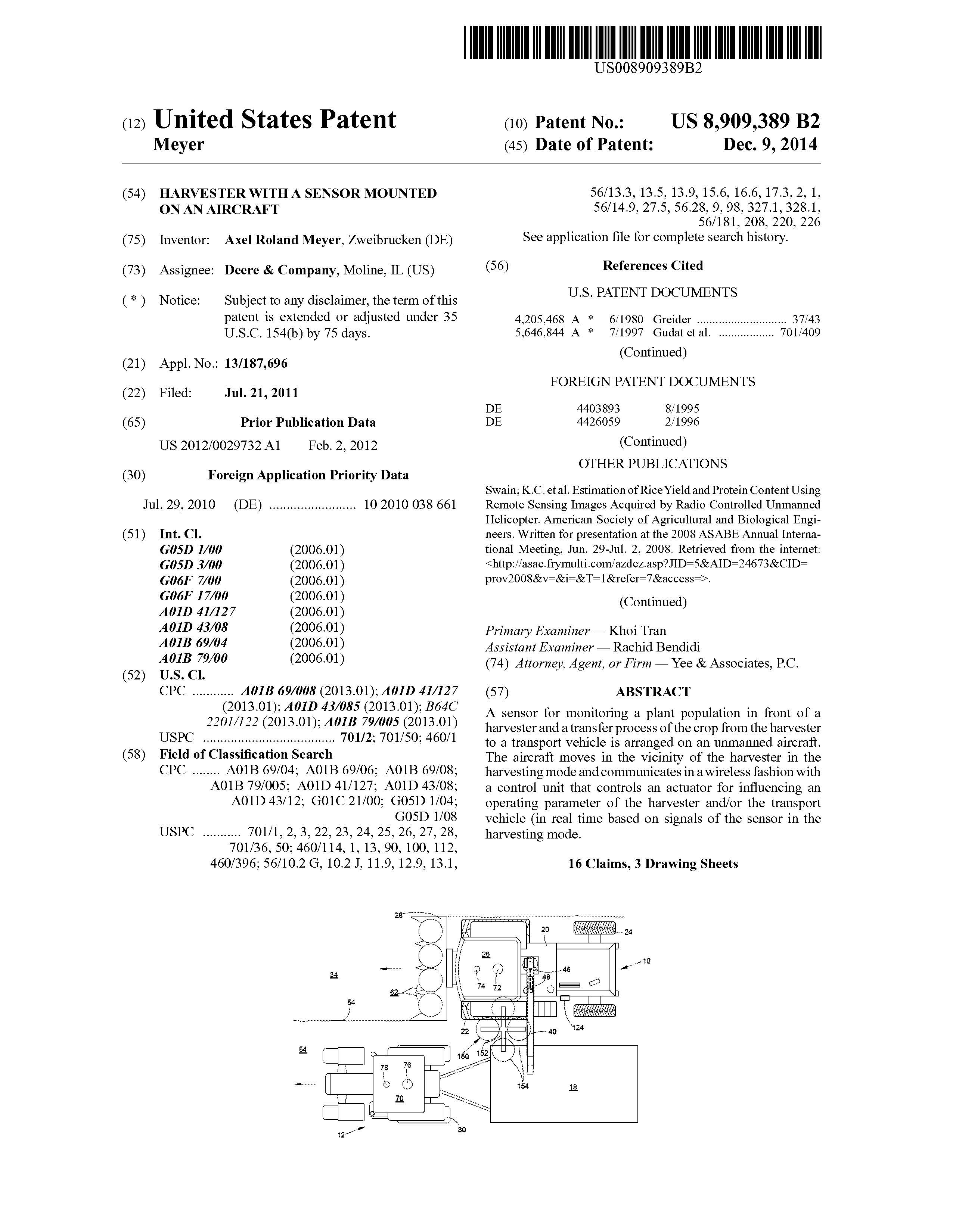Suiter Swantz IP takes a look back at past inventions and inventors with our Patent of the Week.
Now that fall is upon us and harvest is in full swing tractors and other farm machinery can be seen working night and day. One of the most recognizable tractors and farm equipment companies is John Deere®.
 John Deere’s history began in 1837 in Grand Detour, Illinois, when John Deere created a polished-steel plow that allowed for farmers to cut clean furrows in the rough soil. From there, the company’s history and empire began. One of the first patents John Deere received was in 1864 for, IMPROVEMENT IN MOLDS FOR CASTING STEEL PLOWS (U.S. Patent No. 41,203). In 1875, Gilpin Moore developed a plow for the company knows as the “Gilpin Sulky Plow”. This plow allowed for farmers to get off their feet and in a seat; it was John Deere’s most successful product in the 19th century SULKY PLOWS (U.S. Patent No. 164,929).
John Deere’s history began in 1837 in Grand Detour, Illinois, when John Deere created a polished-steel plow that allowed for farmers to cut clean furrows in the rough soil. From there, the company’s history and empire began. One of the first patents John Deere received was in 1864 for, IMPROVEMENT IN MOLDS FOR CASTING STEEL PLOWS (U.S. Patent No. 41,203). In 1875, Gilpin Moore developed a plow for the company knows as the “Gilpin Sulky Plow”. This plow allowed for farmers to get off their feet and in a seat; it was John Deere’s most successful product in the 19th century SULKY PLOWS (U.S. Patent No. 164,929).
In 1876, the company moved to Moline, Illinois and was producing over 60,000 plows a year. With this increase in productivity the company felt there was an obvious need for a trademark. Later  that year John Deere registered the “leaping deer” logo that depicts a deer leaping over a log. In 1912 John Deere registered for a second trademark that had more detail, definition, and incorporated the slogan “The Trade Mark of Quality Made Famous by Good Implements”. In 1936 the company obtained another trademark as they decided to expand on their logo creating one that could easily be stenciled on to products. As styles change so did the logo, their most current trademarked logo (U.S. Registration No. 2,580,000) changed the appearance of the deer; it is now leaping upward instead of landing.
that year John Deere registered the “leaping deer” logo that depicts a deer leaping over a log. In 1912 John Deere registered for a second trademark that had more detail, definition, and incorporated the slogan “The Trade Mark of Quality Made Famous by Good Implements”. In 1936 the company obtained another trademark as they decided to expand on their logo creating one that could easily be stenciled on to products. As styles change so did the logo, their most current trademarked logo (U.S. Registration No. 2,580,000) changed the appearance of the deer; it is now leaping upward instead of landing.
 Not only has John Deere trademarked their logo, the company also trademarked their signature “John Deere Green” and “John Deere Agricultural Yellow” color schemes. In early 1982 Deere tried to block a competitor from using the colors green and yellow on tractor attachments. Unfortunately, the court did not side with John Deere and held that because consumers wanted their tractor accessories to match their tractor, the use of green and yellow was functional. John Deere persisted and applied for different green and yellow layouts on machines. In 1985 the application was again denied based on aesthetic functionality. The company persisted, appealed, and eventually in 1988 Reg. Nos. 1,254,339; 1,502,103; 1,503,576 were allowed.
Not only has John Deere trademarked their logo, the company also trademarked their signature “John Deere Green” and “John Deere Agricultural Yellow” color schemes. In early 1982 Deere tried to block a competitor from using the colors green and yellow on tractor attachments. Unfortunately, the court did not side with John Deere and held that because consumers wanted their tractor accessories to match their tractor, the use of green and yellow was functional. John Deere persisted and applied for different green and yellow layouts on machines. In 1985 the application was again denied based on aesthetic functionality. The company persisted, appealed, and eventually in 1988 Reg. Nos. 1,254,339; 1,502,103; 1,503,576 were allowed.
In 1995 the Supreme Court made a landmark decision regarding color and trademark. They held that a single color could be protected as a trademark. Following this decision, in 2004, it was held that Deere could not simply have rights in every abstract combination of green and yellow on machinery. However, they could protect their rights regarding specific color layouts on specific areas of equipment. Since this decision, Deere has gained a number of trademark registrations regarding color combinations on specific machines
 John Deere has grown exponentially since their inception and are recognized for their innovative and technologically advanced machinery and equipment. A couple examples of those advanced items are BATTERY ELECTRIC HYBRID DRIVE FOR A COMBINE HARVESTER (U.S. Patent No. 8,897,943), and HARVESTER WITH A SENSOR MOUNTED ON AN AIRCRAFT (U.S. Patent No. 8,909,389).
John Deere has grown exponentially since their inception and are recognized for their innovative and technologically advanced machinery and equipment. A couple examples of those advanced items are BATTERY ELECTRIC HYBRID DRIVE FOR A COMBINE HARVESTER (U.S. Patent No. 8,897,943), and HARVESTER WITH A SENSOR MOUNTED ON AN AIRCRAFT (U.S. Patent No. 8,909,389).
Suiter Swantz IP is a full-service intellectual property law firm, based in Omaha, NE, serving all of Nebraska, Iowa and South Dakota. If you have any intellectual property questions or need assistance with any patent, trademark, or copyright matters and would like to speak to one of our patent attorneys please contact us.
